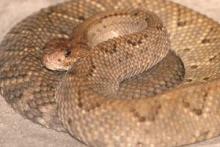LAS VEGAS – In the movies, a savvy hero saves the victim of a rattler by quickly ripping up a shirt to use as a tourniquet, then sucking the venom from the wound. In real life, forget it.
"A cell phone – that's your snakebite kit," said Dr. Cyrus Rangan, director of toxics epidemiology at the Los Angeles County Department of Health Services in his talk on envenomations at the meeting sponsored by the American Academy of Pediatrics California District 9.
Few people suffer from severely toxic bites in the United States, but getting the treatment right is essential in these cases. "When it does happen, it's important to know what your next move is going to be," said Dr. Rangan, who focused on bites by rattlesnakes and spiders.
Snakes bite about 3-4 out of every 100,000 people each year in the United States. A quarter of these are "dry bites" in which no venom is released. Half result in severe morbidity. Deaths are rare.
The most common poisonous snake in the United States is the rattlesnake (Crotalus atrox and Crotalus viridis helleri). The bites usually penetrate only a few millimeters and, as a result, the damage is localized. In the rare case when the venom enters a vein, the consequences can be serious. The teeth usually leave simple puncture wounds, but sometimes they drag along the skin far enough to cause lacerations.
In women, such bites are mostly on the foot, the result of accidentally stepping on or near the snake. "Ninety percent of the time men get bitten on the hand because they're doing something dumb," said Dr. Rangan. He told the story of a man who kissed a rattler on the mouth – and got bitten – in two separate incidents.
Presentation includes stinging, burning pain, distal-to-proximal swelling, blebs and ecchymoses (caused by someone trying to suck out the venom), and occasional oozing from the bite site. Don't worry about the oozing or try to treat with platelets, Dr. Rangan advised.
Patients may also experience nausea, a metallic taste, diaphoresis, paresthesia, and rarely hypotension, arrhythmias, or rhabdomyolysis. Fasciculations (muscle twitching) may occur anywhere in the body – the result of neurotoxins in the venom, said Dr. Rangan.
The venom contains enzymes that promote thrombin-like activity and fibrinolysis. Tourniquets are a mistake because it's better to let the venom circulate rather than be concentrated in one place where it can cause necrosis. Other folk remedies that do more harm than good include extreme icing, attempting to cut away the affected tissue, burning, and even electrotherapy.
What should be done instead? Besides calling a pharmacy to make sure it has the appropriate antivenom in stock, Dr. Rangan said, appropriate first aid includes immobilizing the patient and elevating the bitten extremity above the heart.
At the hospital, he advised doctors to remove all constricting bands, continue to elevate the extremity, monitor the progression of swelling, administer tetanus prophylaxis, and take platelet and fibrinogen labs. Other labs might include CBC, CPK (creatine phosphokinase), Type+Screen in preparation for a possible blood transfusion, and PT (prothrombin time).
The appropriate antivenom is Crotalidae polyvalent immune Fab (CroFab), which is made by injecting sheep with the venom, then isolating the antibodies. CroFab contains intact IgG antibodies digested with papain to yield Fab fragments.
Dr. Rangan advised administering six vials in increments until the cessation of swelling and the stabilization of coagulation abnormalities. Empiric antibiotics and blood products can be considered. Anticipate and treat serum sickness. "Don't forget pain control," he said.
Surgical intervention is rarely needed. Some necrotic tissue debridement might be called for, but fasciotomy is rarely indicated and is the largest contributor to comorbidity, he added.
Dangerous Spiders
Dr. Rangan emphasized that the brown recluse spider (Loxosceles reclusa) is confined almost entirely to the central Southern states, and even there bites are extremely rare. Likewise, he said, tarantula (Theraphosidae) bites are mostly more painful than damaging. These spiders also can eject barbed hairs, which are generally only serious if they get into a patient's eyes.
Black widows (Latrodectus), on the other hand, can cause major havoc. "If there is one spider you have to worry about, this is the one," said Dr. Rangan. These bites can be fatal in small children or the frail elderly.
The bites are single needle-like puncture wounds. A quarter is dry bites that cause little harm, but 60% present with an erythematous macule, 30% with a "target" lesion, 5% with an erythema marginatum, and 5% with tiny distinct dual fang marks. "If you see a patch of sweat and a little red dot, it's virtually pathognomonic," said Dr. Rangan.



